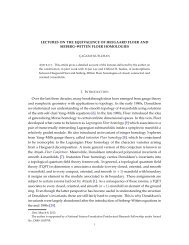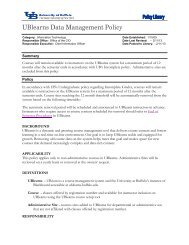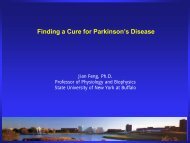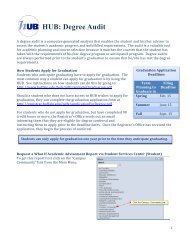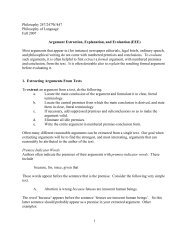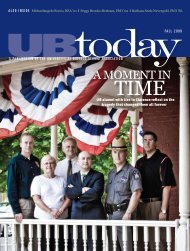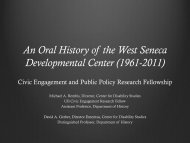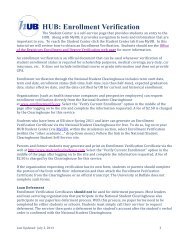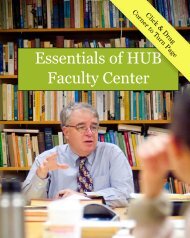Why children are getting and what UB is - University at Buffalo
Why children are getting and what UB is - University at Buffalo
Why children are getting and what UB is - University at Buffalo
You also want an ePaper? Increase the reach of your titles
YUMPU automatically turns print PDFs into web optimized ePapers that Google loves.
to do the activities with peers <strong>and</strong> friends.”<br />
According to Salvy, <strong>UB</strong> researchers<br />
want to better underst<strong>and</strong> “how social<br />
<strong>is</strong>ol<strong>at</strong>ion resulting from teasing <strong>and</strong> weight<br />
critic<strong>is</strong>m may decrease the motiv<strong>at</strong>ion<br />
to be physically active <strong>and</strong> involved with<br />
peers, <strong>and</strong> increase the time spent e<strong>at</strong>ing<br />
<strong>and</strong> doing sedentary activities.”<br />
She adds: “We <strong>are</strong> now starting a new<br />
series of studies on the effect of peer rejection<br />
versus peer acceptance on e<strong>at</strong>ing in<br />
overweight <strong>and</strong> non-overweight youth.<br />
We <strong>are</strong> also interested in examining overweight<br />
youth’s emotional responses to<br />
social conflicts.”<br />
Although it’s impossible to mention<br />
every <strong>UB</strong> research study on childhood<br />
obesity conducted over 20 years, there<br />
<strong>is</strong> one other current study th<strong>at</strong> deserves<br />
particular note. Th<strong>is</strong> <strong>is</strong> Roemmich’s work<br />
on “how psychological stress influences<br />
weight st<strong>at</strong>us.”<br />
“We have shown th<strong>at</strong> <strong>children</strong> who<br />
have gre<strong>at</strong>er increases in heart r<strong>at</strong>e <strong>and</strong><br />
blood pressure when giving a speech about<br />
themselves, increases their e<strong>at</strong>ing of comfort<br />
food <strong>and</strong> reduces their willingness to<br />
be physically active,” Roemmich explains.<br />
“They would r<strong>at</strong>her w<strong>at</strong>ch telev<strong>is</strong>ion when<br />
stressed. From these results you would<br />
expect th<strong>at</strong> <strong>children</strong> who <strong>are</strong> the most<br />
stress-reactive <strong>are</strong> more overweight, <strong>and</strong><br />
we have shown th<strong>is</strong> associ<strong>at</strong>ion.”<br />
The child obesity research <strong>at</strong> <strong>UB</strong> <strong>is</strong><br />
funded by the N<strong>at</strong>ional Institutes of<br />
Health, a grant from the Found<strong>at</strong>ion for<br />
Healthy Living (Blue Cross/Blue Shield)<br />
<strong>and</strong> a Robert Wood Johnson Found<strong>at</strong>ion<br />
grant, among other funding sources.<br />
Looking back on h<strong>is</strong> years of research,<br />
Epstein says th<strong>at</strong> he <strong>and</strong> h<strong>is</strong> tre<strong>at</strong>ment<br />
team often hear <strong>wh<strong>at</strong></strong> happened to some<br />
<strong>children</strong> once a tre<strong>at</strong>ment study <strong>is</strong> over.<br />
“We get feedback from p<strong>are</strong>nts about<br />
<strong>children</strong> becoming more social <strong>and</strong> having<br />
more friends; becoming active <strong>and</strong> joining<br />
<strong>and</strong> starring on <strong>at</strong>hletic teams,” Epstein<br />
st<strong>at</strong>es.<br />
“I am most pleased with the fact th<strong>at</strong><br />
we had an impact on the quality of life of<br />
these <strong>children</strong> <strong>and</strong> their families.”<br />
Susan M. LoTempio has been an editor <strong>at</strong><br />
the <strong>Buffalo</strong> News for 22 years.<br />
16 Winter 2009 <strong>UB</strong>TODAY www.alumni.buffalo.edu



